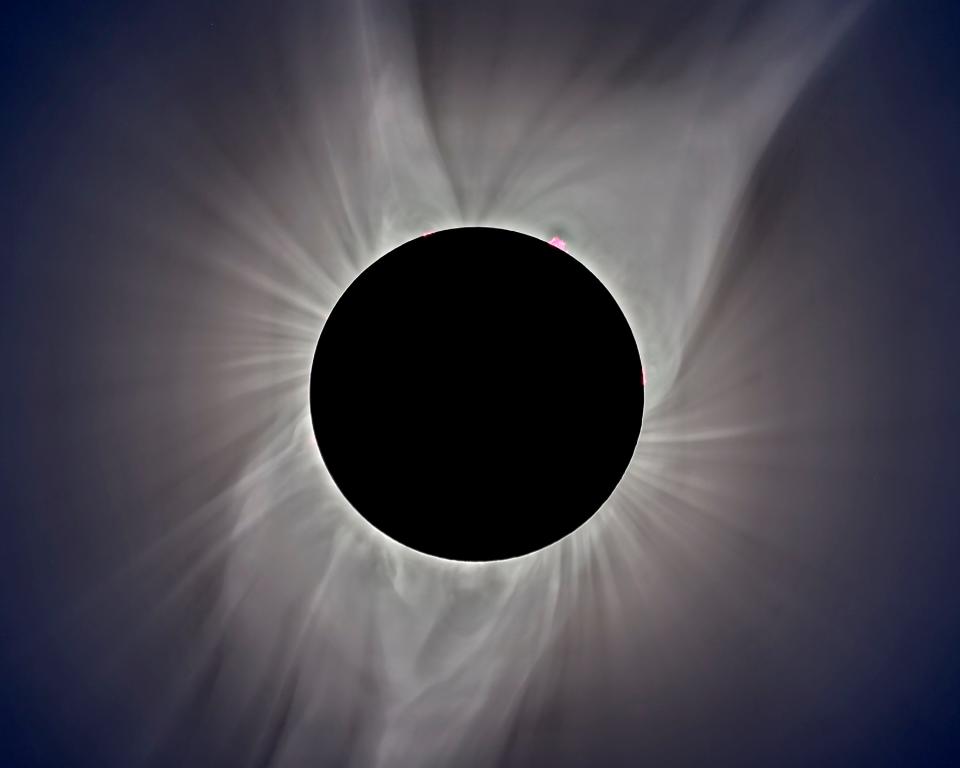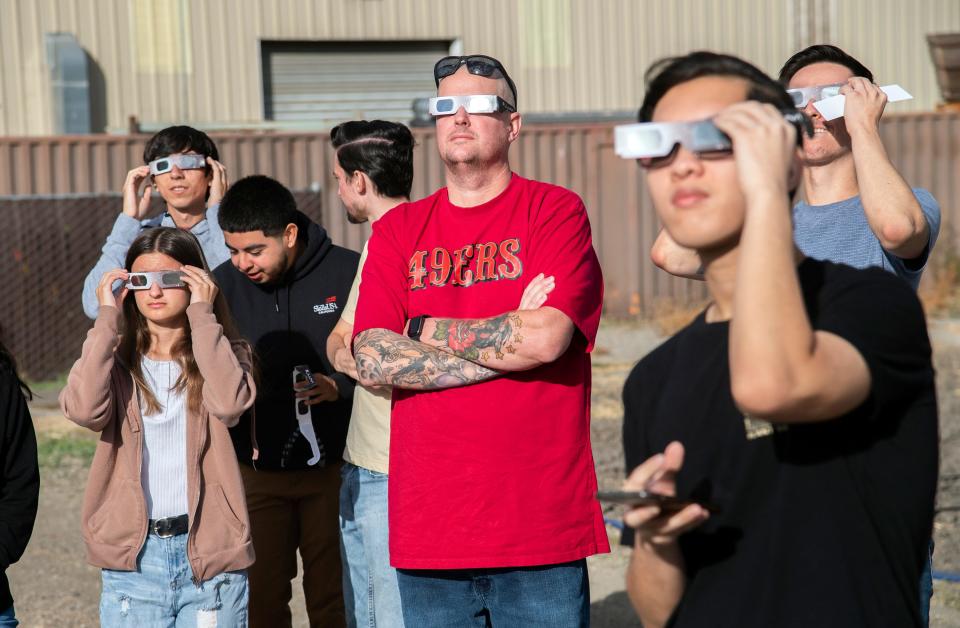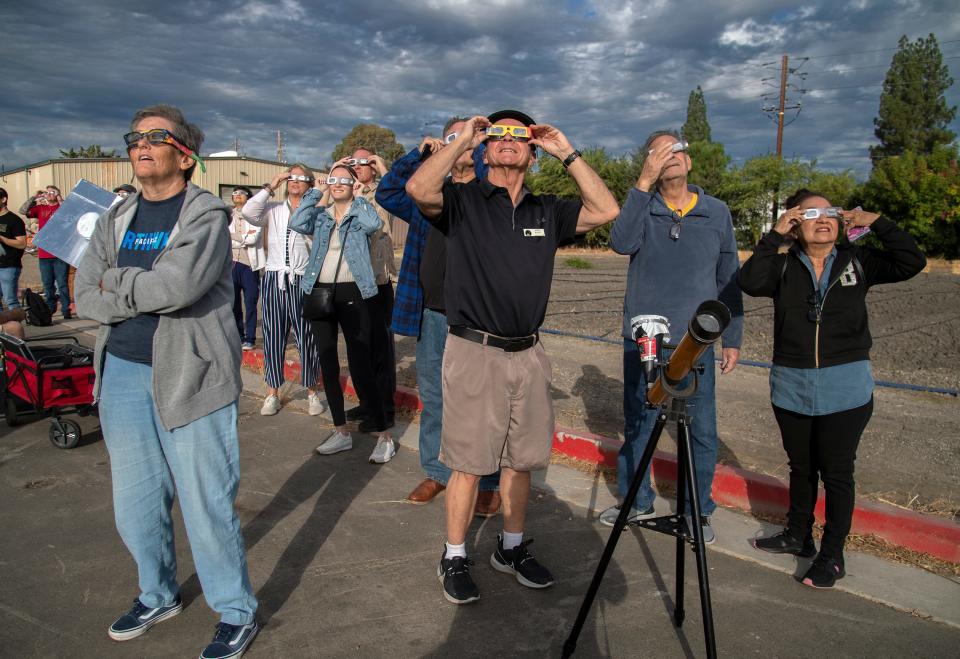Want to see the solar eclipse on April 8? Find out times, where to get glasses in Stockton
In less than two weeks, a total solar eclipse is expected to cast a portion of North America in darkness.
On April 8, the Great North American Eclipse will trace a narrow path of totality across 15 U.S. states. Outside this path of totality, most of the rest of the country will experience a partial solar eclipse, including Stockton and California as a whole.
The 2024 solar eclipse will begin at 10:14 a.m. and reach the maximum 35.7% totality, or coverage, around 11:15 a.m. in Stockton. It will conclude with a final partial eclipse at 12:18 p.m.
This year’s total solar eclipse will last longer than the one viewed by more than 215 million Americans in August 2017, and according to NASA won’t happen again for another 20 years. The next total solar eclipse that can be seen from the contiguous United States will be on Aug. 23, 2044.
Here's what to know about the 2024 solar eclipse and how to prepare.
What is a solar eclipse?

A total solar eclipse happens when the moon passes between the sun and Earth, completely blocking the face of the sun, according to NASA. People located in the center of the moon’s shadow when it hits Earth will experience a total eclipse.
The sky will darken as if it were dawn or dusk, NASA said. If weather permits, people in the path of a total solar eclipse can see the sun’s corona, or outer atmosphere, which is usually obscured by the bright face of the sun.
More: Stockton readers take pictures of reflections for photo challenge
This total solar eclipse will be visible in 15 U.S. states, and a partial solar eclipse will be visible in all 49 continental states.
States in the path of totality for the 2024 solar eclipse include Texas, Oklahoma, Arkansas, Missouri, Illinois, Kentucky, Indiana, Ohio, Pennsylvania, New York, Vermont, New Hampshire and Maine. Tennessee and Michigan will get a small slice.
How to view a solar eclipse safely

Looking at a solar eclipse without proper protection can lead to serious eye damage, including blurry vision that could last for months. It may even cause permanent problems such as "eclipse blindness" or retinal burns.
To prevent eye damage, optometrists recommend using solar eclipse filters and glasses from reputable manufacturers. The proper eyewear should comply with the requirements of the ISO 12312-2 international standard.
The American Astronomical Society warns against buying eclipse glasses at the lowest price from online marketplaces such as Amazon or eBay. A curated list of approved vendors can be found on its website.
Read more: Sacramento River Delta makes for fun, scenic exploration
When using solar eclipse filters and glasses, the American Astronomical Society recommends the following safety tips:
Always inspect your solar filter before use; if scratched, punctured, torn, or otherwise damaged, discard it. Read and follow any instructions printed on or packaged with the filter.
Always supervise children using solar filters.
If you normally wear eyeglasses, keep them on. Put your eclipse glasses on over them, or hold your handheld viewer in front of them.
Stand still and cover your eyes with your eclipse glasses or solar viewer before looking up at the bright Sun. After looking at the sun, turn away and remove your filter — do not remove it while looking at the sun.
Do not look at the uneclipsed or partially eclipsed sun through an unfiltered camera, telescope, binoculars, or other optical device.
Similarly, do not look at the sun through an unfiltered camera, telescope, binoculars, or any other optical device while using your eclipse glasses or handheld solar viewer in front of your eyes — the concentrated solar rays could damage the filter and enter your eyes, causing serious injury.
Seek expert advice from an astronomer before using a solar filter with a camera, telescope, binoculars, or any other optical device; note that solar filters must be attached to the front of any telescope, binoculars, camera lens, or other optics.
Where to find free solar eclipse glasses in San Joaquin County

Free solar eclipse glasses are available at the following Stockton and San Joaquin County public libraries:
Cesar Chavez Central Library, 605 N. El Dorado St., Stockton
Margaret K. Troke Branch Library, 502 W. Benjamin Holt Drive, Stockton
Maya Angelou Branch Library, 2324 Pock Lane, Stockton
Weston Ranch Branch Library, 1453 W. French Camp Road, Stockton
Ripon Branch Library, 333 W. Main Street, Ripon
The Angelou library has a limit of six glasses per household, while the Troke and Ripon libraries have a limit of two per household.
Read more: Once the U.S.'s leading cause of death, tuberculosis has spiked in San Joaquin County
Record reporter Hannah Workman covers news in Stockton and San Joaquin County. She can be reached at hworkman@recordnet.com or on Twitter @byhannahworkman. Support local news, subscribe to The Stockton Record at https://www.recordnet.com/subscribenow.
This article originally appeared on The Record: April 2024 solar eclipse guide: Free glasses, times in Stockton

